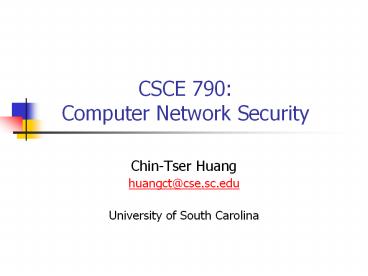CSCE 790: Computer Network Security - PowerPoint PPT Presentation
Title:
CSCE 790: Computer Network Security
Description:
CSCE 790: Computer Network Security Chin-Tser Huang huangct_at_cse.sc.edu University of South Carolina – PowerPoint PPT presentation
Number of Views:164
Avg rating:3.0/5.0
Title: CSCE 790: Computer Network Security
1
CSCE 790Computer Network Security
- Chin-Tser Huang
- huangct_at_cse.sc.edu
- University of South Carolina
2
About Me
- Chin-Tser Huang
- Ph.D. in Computer Sciences, 2003, University of
Texas at Austin - My first semester with USC
- Research in network security, network protocol
design and verification, distributed systems - My new web page is not ready, but if you want to
know more about me, here is the old one
http//www.cs.utexas.edu/users/chuang
3
About the Course
- A grad-level seminar course focusing on basics
and issues in network security - First half will be lectures about elements of
network security, cryptography backgrounds, and
introduction to network security designs - Second half will be your chance to present what
you have learned from key research papers
4
Course Information Online
- http//www.cse.sc.edu/huangct/CSCE790F03/index.ht
m - List of assigned paper and useful links will be
added shortly - Lecture slides will be available online too
5
Your Best Strategy
- Come to every lecture to learn basic security
problems and skills to counter them - Keep yourself exposed to articles related to
network security to collect project ideas - Read each assigned paper and write good summary
for each paper - Do not wait till last minute to prepare for exam
or work on project - Enjoy the fun!
6
What Can Go Wrong
- when your computer y receive or is waiting for a
message m?
?
Internet
m
x
y
7
Message Loss
- Adversary A can discard m in its transit
A
m
x
y
8
Message Interception
- Adversary A can get a copy of m when m passes by
m
A
m
m
x
y
9
Message Modification
- Adversary A can arbitrarily modify the content of
m to become m
A
m
m
x
y
10
Message Insertion
- Adversary A can arbitrarily fabricate a message
m, pretending that m was sent by x
src x dst y
A
m
x
y
11
Message Replay
- Adversary A can replay a message m that has been
sent earlier by x and received by y
m
A
m
x
y
12
Denial-of-Service Attack
- Adversary A can send huge amount of messages to y
to block m from arriving at y
A
m
?????
x
y
13
Type of Attacks
- Passive attacks
- Traffic analysis
- Message interception
- Active attacks
- Message loss
- Message modification
- Message insertion
- Message replay
- Denial-of-Service attack
14
Network Security Services
- Confidentiality
- Integrity
- Authentication
- Anti-replay
- Availability
- Access control
- Non-repudiation
- Anonymity
15
Confidentiality
- Keep message known only to the receiver and
secret to anyone else - Counter message interception
16
Integrity
- When receiver receives message m, receiver can
verify m is intact after sent by sender - Counter message modification
17
Authentication
- When receiver receives message m, receiver can
verify m is indeed sent by the sender recorded in
m - Counter message insertion
18
Anti-replay
- When receiver receives message m, receiver can
verify m is not a message that was sent and
received before - Counter message replay
19
Availability
- Property of a system or a resource being
accessible and usable upon demand by an
authorized entity - Counter denial-of-service attack
20
Access Control
- Mechanism to enforce access rights to resources
and data - Users can access resources and data to which they
have access rights - Users cannot access resources and data to which
they dont have access rights
21
Non-repudiation
- When receiver receives message m, receiver gets
proof that sender of m ever sent m - Receiver of m can show proof to third-party so
that sender of m cannot repudiate
22
Anonymity
- Identity of sender is hidden from receiver
- When receiver receives message m, receiver has no
clue about sender of m
23
Network Security Is Great
- Prevent messages from being attacked in their
transit - Detect and discard messages that are modified,
inserted, or replayed - Disallow unauthorized access to local system
resource and sensitive data
24
But Hard To Achieve
- Many layers in network architecture
- Many different media of network connection
- Adversarys location hard to determine
- New attacks keep emerging
- Cryptographic overhead
25
Why Should You Take This Course
- Security is an increasingly important issue
- You want to have basic knowledge about network
security - You can learn latest attacks and newest skills to
counter those attacks - You have a chance to implement the skills learned
in the class

